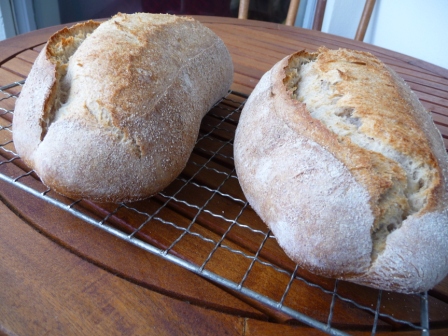
Vermont Bread - The Saga continues
My training in making sourdough bread continues with growing success. See previous report here. I have followed advice I received on TFL to stick with a recipe that works for me to gain experience and skill. Doing the same recipe over and over again helps me to compare the outcome and learn from it. The recipe is from Home Cooking Adventure: Easy Sourdough Bread - Vermont Bread.
This was the first Vermont Bread I made:

Here is the second bake:



And now the third bake:

The obvious change from the first bake to the second is the oven spring. The first time around I let the shaped loaves proof for 2,5 hours but only for 2 hours for the second and third bake. I think this made the difference so that the dough still had some work to do when it reached the oven. The slashing has also improved. The cuts are deeper and at a greater angle than at the first bake. For the third bake I dusted the proofing baskets with rye instead of white flour. I use my Kenwood for the kneading as my arms and shoulders are not fit for heavy duty. I tried Bertinet's method of slamming the dough on the table but it was too heavy for me with the repeated motion. I don't get the famous window pane effect, no matter how long I let the machine knead the dough. I wonder if that does not happen as much with rye dough than with white flour only. I guess I'll find out when I try my hand at a French bread later on.


Comments
Nice oven spring. Is the texture of the bread different with the proofing times? Like, is one lighter and fluffier than the other?
I think for the window pan stretching to happen, the dough should relax for a length of time, probably half hour to an hour. Because if you try to stretch it immediately after kneading it, it tends not to stretch. All that kneading makes the dough very tensed because of the gluten formation.
Would taking a rolling pin and banging it on the dough work for gluten development? LOL I'm tempted to try.
Thanks for checking in.
Yes, the texture is lighter and less rubbery witht shorter proofing. I think the two and half hours made the dough proof fully so there was no work left for the heat to do. This Vermont recipe gives a softer crumb than the San Francisco Sourdoughs which I have tried. Those were really rubbery and I don't like that. The Vermont Bread does not have as much hydration.
I'll check for the window pane after resting before folding, just to see if it happens.
Interesting. I'll make a note of the proofing time. Thank you!
I guess it matters - the room temperature in my kitchen is 20-21°C
Your loaves looked good right from the first bake and the improvement with each bake is noticable. They look great now. After baking countless loaves of bread of all types, the next time I do the window pane test will be the first. We all have our own style and techniques for baking bread. Should that includes the window pane test and that works for you, fine. If not, do not lose any sleep over it.
Happy Baking, Jeff
Thanks, I am content, even in my sleep :-)